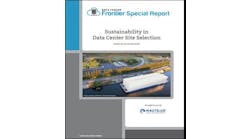Market Changes Drive the Evolution of Data Center Management
Outsourcing is a trend found in almost every sector of the economy, and the data center industry is no exception. This launches our article series on how data center facility management is evolving REIT and data center provider operational models.
Get the full report.
The requirements of today’s modern IT environment indicate the need for high levels of agility. This doesn’t just revolve around the technology, but also shifting and adapting to market and business demands. This means seamlessly scaling an environment based on IT and business goals for a data center.
Outsourcing is a growing trend within almost every vertical and business segment. But what happens when too much is placed on the plates of data center and business leaders? Suddenly, they focus more on managing various facility details than ensuring optimal operations of the data centers, and every leader needs to ask whether outsourcing in a particular area makes sense and is cost-efficient.
Facility management outsourcing allows today’s organizations to have a more successful digital transformation strategy.
This is where we begin to shift our thinking regarding REITs, data centers, and managing vast data center campuses. In many situations, facility management outsourcing, depending upon the needs and specific peculiarities of the facility type and the data center provider or REIT’s business—will help an organization become a flexible public company rather than a collection of properties. Also, facility management outsourcing allows today’s organizations to have a more successful digital transformation strategy. This is the crucial difference to remember. And this is the operational change that’s helping leaders in the REIT and data center space become more operationally efficient and save quite a bit of time and money in the process.
This series of articles takes an entirely new approach to deliver real-world data center success. We’ll examine the importance of outsourcing, how data centers are seen as an asset class, how outsourcing directly impacts EBIDTA, and how you can deliver thought leadership through outsourcing and market differentiating services.
Market Changes Drive Data Center Management Evolution
There has been substantial growth in the data center sector. A new report from Fortune Business Insights indicates that the global demand for more efficient IT technologies combined with the economic advantages of modern, consolidated connectivity applications has contributed to the exponential rise in data centers’ scale and power. As the report points out, the global data center infrastructure market size is projected to reach $142.31 billion by 2027, compared to 2019, when the global market value stood at $94.56 billion.
“The ever-increasing need for data exchange, storage, and security is broadening demand for data centers in the U.S., but one solution does not fit all.” Pat Lynch, Executive Managing Directors of Data Center Solutions at CBRE
Expanding utilization of data centers by organizations amid the Covid-19 pandemic further fueled this market’s growth and the importance of a businesses’ agility in the online space. Furthermore, the rapidly evolving competitiveness in the global market and advanced technologies, such as cloud computing and big data, has made it simpler and cheaper for enterprises to shift their workload to colocation, self-contained, or hyperscale data centers.
This growth translates to more data center provider and REIT expansions, driving new supply. A recent CBRE study indicates that the U.S. wholesale data center primary markets – Atlanta, Chicago, Dallas/Ft. Worth, New York Tri-State, Northern Virginia, Phoenix, and Silicon Valley – accounted for more than 56% of the record annual absorption in 2018. New deliveries increased these primary markets’ total data center inventory by 17.3% in 2019, increasing the competition among specific markets in 2020.
New supply comes primarily from two sources: new providers bringing their first capacity online and expansions by existing providers. Competition between providers will continue to drive market pricing and contractual terms, creating aggressive leasing scenarios. End-users seek creative Hybrid IT environments through efficient right-sizing, enabling them to take advantage of both the new supply and government incentives.
With this in mind, how much does it actually cost to run a data center? In the U.S., the average 5-megawatt data center costs $270.1 million to operate over 10 years, according to CBRE. Costs will jump from $276 million to $368.4 million for Boston, Chicago, and Silicon Valley data centers.
“Capital and operating costs vary considerably by market, and non-monetary factors such as proximity to a headquarters location, fiber density, and environmental and other risk factors can also drive enterprise site seleciton decisions.” Pat Lynch, Executive Managing Directors of Data Center Solutions at CBRE
On the low end of the spectrum, enterprises can expect to pay $227.5 million to $248.3 million by setting up shops in markets like Atlanta, Omaha, and Portland, Oregon.
Today, leaders in the business and IT space are always under constant pressure to reduce the overall operational cost of business, including the cost associated with IT operations. The in-house data center adds huge expenses coupled with the substantial investment level required to deploy and maintain modern, energy-efficient data center infrastructure. This makes data center outsourcing solutions and services a better alternative, thus positively impacting the global data center infrastructure outsourcing market growth.
Working with leaders in the facility management space will positively impact operational models, EBIDTA, and an organization’s ability to be agile in the market. As mentioned earlier, these types of partnerships allow data center and REIT leaders to become true technology companies rather than a collection of locations and properties.
In the coming articles in this series, we will explore the significant changes related to facility management and outsourcing. Further, we’ll review real-world examples of how outsourcing directly impacts a company’s ability to respond to the market while lowering costs and improving EBIDTA. Finally, we’ll cover how these specific partnerships are the engine to help technology leaders break away from legacy data center paradigms regarding facility management.
To gain a better understanding of REITs and data center leaders are evolving their operational models and facility management strategies, we’ll examine the following:
- Critical trends around today’s data center market
- Outsourcing: legacy versus modern approaches
- The data center as an asset class
- How outsourcing improves colocation, data center provider, enterprise, and REIT financials and EBIDTA
- Focusing on data center provider, enterprise, and REIT core competencies and where partners will help
Download the entire paper, “Focusing on Data Center Expertise,” courtesy of CBRE, to learn more. In out next article, we’ll look at the changing data center landscape – legacy versus digital.






